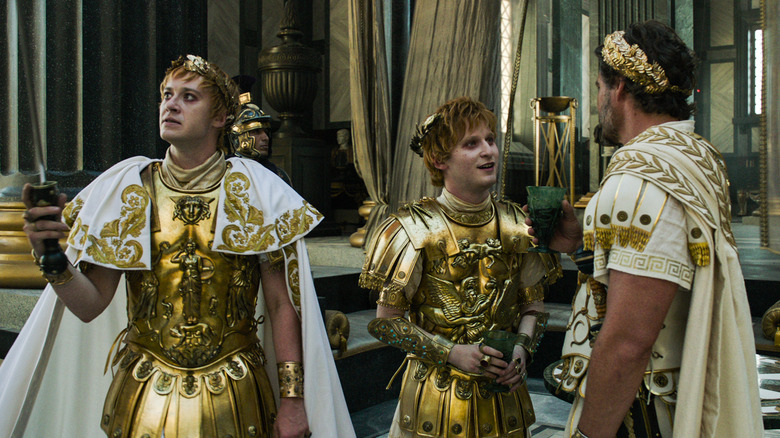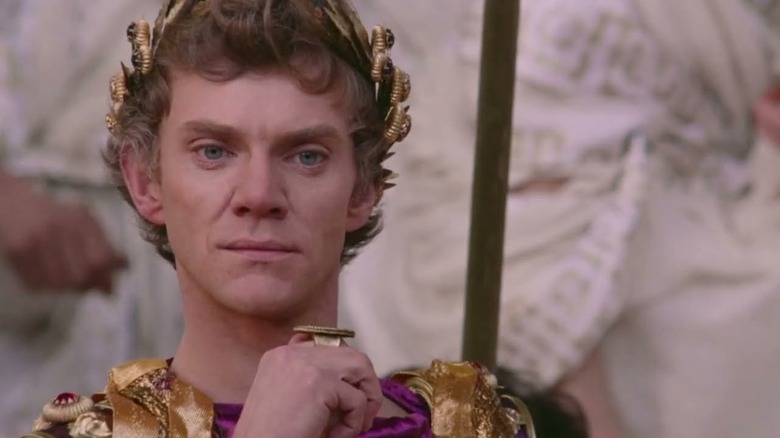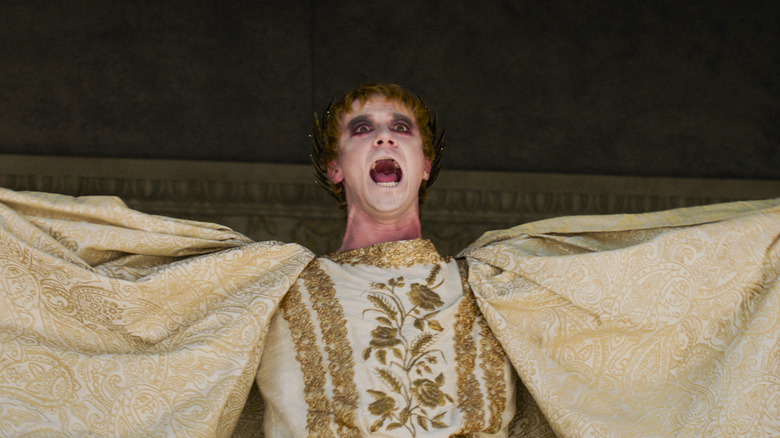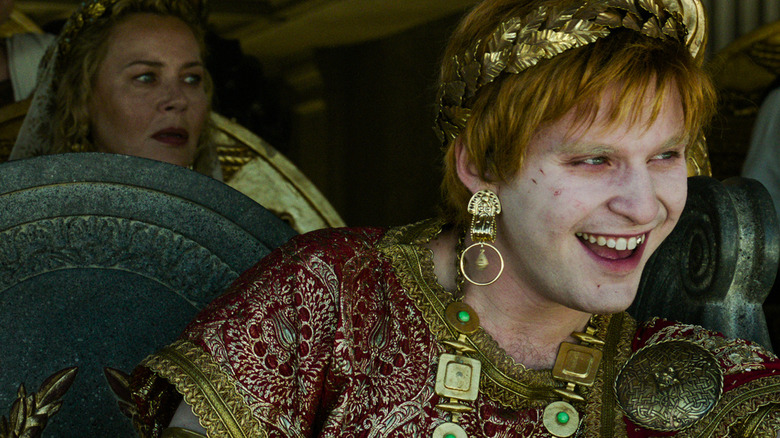Gladiator 2's Decadent Emperors Echo One Of The Most Infamous Movies Ever Made
This piece contains some spoilers for "Gladiator II."
In this month's "Gladiator II," Rome does not fall — but it comes damn close. It's also not for lack of trying, as both the manipulative ex-slave Macrinus (Denzel Washington) and our ostensible hero, Lucius (Paul Mescal), have no love for the Empire, with both men actively seeking to usurp, disrupt or combat its rule. Even though Lucius eventually changes his mind and finds himself believing in a "dream of Rome" begun by his grandfather Marcus Aurelius, and his father, Maximus (Russell Crowe in the first "Gladiator"), it may be too late, as the Empire has been nearly irrevocably tarnished by decades of decadence and misrule. The two men most responsible for this are the Emperors Geta (Joseph Quinn) and Caracalla (Fred Hechinger), a couple of Enfant Terribles who director Ridley Scott told Vanity Fair he saw as "almost a replay of Romulus and Remus," the twin brothers whose quest to found Rome ended in Romulus killing Remus. That moment has its echoes in "Gladiator II" (and, interestingly, makes "Gladiator II" the second Scott production of 2024 which invokes the legacy of Romulus and Remus).
Although Quinn and Hechinger apparently looked to a number of inspirations for their respective characters (more on that in a bit), their combined effect within the movie also recalls an infamous film about another hedonistic and insane Roman emperor: 1979's "Caligula." To be fair, "Gladiator II" never once attempts to be as controversial or as boundary-pushing as "Caligula"; Scott's too much of a consummate A-list director to risk the sequel's $300-million-something budget on doing something potentially alienating. Yet within "Gladiator II" lies the same director who made "The Counselor" (which did, indeed, alienate some audiences), and thus, the film's depiction of Geta and Caracalla can stand alongside Malcolm McDowell's Caligula as some of the most ecstatically evil cinematic Roman emperors.
Geta and Caracalla channel Caligula in Gladiator II
As Hannah Shaw-Williams details in her piece, "Gladiator II" features a particularly loose and thorny adaptation of the real-life Geta and Caracalla. As she observes, and as is blatantly evident in many other places, Ridley Scott loves to play fast and loose with history, essentially cherry-picking what elements he wants to keep while changing and/or discarding the rest. Thanks to the fact that the film's trailers and pre-release interviews alone indicate that the film will not feature period-accurate depictions of the emperors, it's safe to say that the Geta and Caracalla of "Gladiator II" are more accurately described as archetypal characters who have a loose relation to actual historical figures.
In that vein, it feels like Scott, Quinn, Hechinger, and writer David Scarpa used all of the most well-known unsavory facts about the real emperors to position their fictionalized versions as the "vulgar/hedonistic/evil Roman emperor" archetype. The concept of such a person, likely born thanks to the heinous doings of the real emperors during Roman times, appears in various artistic mediums over the centuries. As far as cinema is concerned, one of the most superlative early examples is Charles Laughton as Nero in Cecil B. DeMille's "The Sign of the Cross," from 1932. That performance was so influential, one can see echoes of it (in parody form, of course) in Dom DeLuise's Nero from Mel Brooks' "History of the World, Part I."
Two years before Brooks' film, however, Malcolm McDowell appeared in director Tinto Brass' controversial "Caligula," and despite all the noise surrounding the movie's production and its inclusion of hardcore pornography in its theatrical cut (thanks to producer and Penthouse magazine publisher Bob Guccione), McDowell's performance brought a much more youthful edge to Caligula's demented actions. So much of his work in the film, whether it's his bug-eyed intensity, wiry physicality, or look of lustful mania, echoes in the performances of Quinn and Hechinger in "Gladiator II."
How Geta, Caracalla, and Caligula exhibit a chaotic punk aesthetic
McDowell's casting in "Caligula" was partially due to the screen persona he'd created for himself during his breakout years in the early 1970s. In the films of Lindsay Anderson ("If..." and "O Lucky Man!") as well as Stanley Kubrick's "A Clockwork Orange," McDowell captured the vibe of that generation's disaffected rebelliousness, a malaise that could turn into either revolution or violence (or, sometimes, both) at the drop of a hat. This means that his "Caligula" is not a Nero type, whose appetites are reflected in their overweight stature and who rules with a decadent authority. Rather, he's a punk rocker: someone young, full of piss and vinegar, and who takes what he wants and acts with an impunity born out of the misconception that he is immortal.
As a result of McDowell's Caligula establishing this alternative punk style for the "crazy Roman emperor" archetype, some of the people Quinn and Hechinger used as touchstones for creating their characters of Geta and Caracalla are '70s punk figures Johnny Rotten and Sid Vicious, as Hechinger revealed to Screen Rant. Thus, the Emperors in "Gladiator II" look and sound very similar to McDowell's Caligula, from their temper tantrums to their Joker-like manic glee to their bi- (or, more likely, pan-) sexual vibes.
Gladiator II pays sly homage to the real Caligula's false legend
In addition to Scott's film making use of the Emperor archetype that Brass' movie helped popularize, "Gladiator II" also cleverly pays homage to an infamous legend that was passed around about the real-life Caligula. Supposedly, Caligula made plans to appoint his favorite horse, Incitatus, to the role of consul, and expected the rest of Roman authority and society to treat Incitatus as they would any other consul, up to and including attending dinner parties with him and the like. This legend has since been debunked by many sources and historians, with some saying it was a full-on fabrication while others say its suggestion could've been a mere prank or satire. Yet its popularity, especially as a shorthand for Caligula's provocation and madness, has allowed the legend to endure.
While the appointment of his horse to consul is not featured in "Caligula," "Gladiator II" draws the comparison between Caligula and Caracalla even further, when the latter insists on the appointment of his pet monkey, Dundus, to consul. Not only is this a great bit of satire on the film's part, it also deftly demonstrates how devolved the Empire is at that moment in the film, and allows Caracalla's character to be deepened through this connection to Caligula and his reputation.
Through these choices, "Gladiator II" joins films like "The Sign of the Cross" and "Caligula" (and even, in a way, this year's "Megalopolis") as great epics involving the decadence and potential fall of Rome. Now that "Gladiator II" is released and "Caligula" has been restored and re-edited to better fit screenwriter Gore Vidal's original plans for the film in this year's finally-available "Ultimate Cut," you can finally have your own little crazy punk Roman emperor marathon.
"Gladiator II" is in theaters now.



